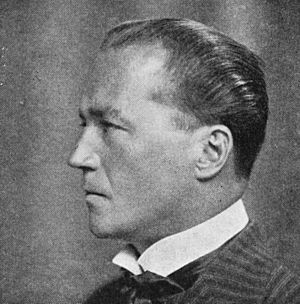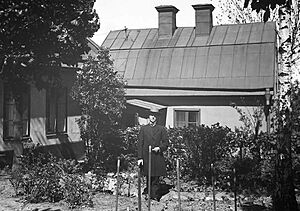Ture Rangström facts for kids
Anders Johan Ture Rangström (born November 30, 1884 – died May 11, 1947) was a Swedish composer. He was part of a new group of musicians. They brought a modern style of music to Sweden in the early 1900s. Besides writing music, Rangström also worked as a music critic. He was also a conductor, leading orchestras.
Contents
About Ture Rangström's Life
Ture Rangström was born in Stockholm, Sweden. When he was a teenager, he started writing songs. His music teacher gave him good advice. The teacher told him to "vary the harmonies a bit more, make it a bit wilder!" Ture followed this advice. Soon, his friends gave him a nickname: "Sturm-und-Drangström." This name came from a German phrase meaning "storm and stress."
In 1905 and 1906, Ture traveled to Berlin. There, he studied music with Hans Pfitzner. He also learned singing from Julius Hey, a famous singer of Wagner's music. Ture later went to Munich to study more with Hey. Most of the music he wrote during this time was for voice and piano.
From 1907 to 1922, Ture Rangström taught singing. Then, from 1922 to 1925, he became the main conductor. He led the Gothenburg Symphony Orchestra. In 1924, he helped start the Swedish Society of Composers. This group supported Swedish music writers. From 1931 to 1936, he worked to promote the shows at the Royal Swedish Opera.
After this, he worked on his own as a freelance artist. People in Sweden raised money to celebrate his fiftieth birthday. With this money, they gave him an island called Törnsholmen. He spent his summers there.
Ture Rangström passed away in his Stockholm home. He had been sick for a long time with a throat disease. His funeral was held at Maria Magdalena Church in Stockholm. He is buried in the churchyard at Gryt, in southeast Sweden. Ture Rangström's grandson, also named Ture Rangström, is a playwright. His uncle was the author Lars Gyllensten.
Ture Rangström's Music
Ture Rangström wrote many different types of music. His early works were often "symphonic poems." These are pieces of music that tell a story or describe a scene. Some of his famous symphonic poems include Dityramb (1909) and En höstsång (An autumn song).
After his symphonic poems became popular, Rangström started writing "symphonies." A symphony is a long piece of music for a large orchestra. He wrote four symphonies:
- His first symphony (1914) is called August Strindberg in memoriam. It honors the famous writer August Strindberg.
- His second symphony (1919) is titled Mitt land (My country).
- His third symphony (1929) is named Sång under stjärnorna (Song under the stars).
- His fourth symphony (1936) is called Invocatio. It is for orchestra and organ.
Rangström also composed three "operas." An opera is a play where the words are sung instead of spoken.
- His first opera was Kronbruden (The Crown Bride). It was based on a play by Strindberg and first performed in 1915.
- His second opera was Medeltida (Medieval), published in 1921.
- His third opera was Gilgamesj. This opera was based on an ancient story called the Epic of Gilgamesh. He worked on it during the last years of his life. Another composer, John Fernström, finished the music for Gilgamesj. It was first performed in 1952.
Besides these larger works, Ture Rangström wrote almost 300 songs. He also arranged about 60 of his songs for an orchestra to play.
Types of Music He Wrote
Ture Rangström wrote music for many different groups of instruments.
For Orchestra
He composed many pieces for a full orchestra. These include his symphonic poems and symphonies. He also wrote suites, which are collections of short musical pieces. Examples include Intermezzo drammatico and Divertimento elegiaco.
For Smaller Groups of Instruments
He also wrote "chamber music." This is music for a small group of instruments, often played in a smaller room. One example is his String quartet in G minor. He also wrote suites for violin and piano, like Suite in modo antico.
For Piano
Rangström composed many pieces just for the piano. These include Fyra preludier (Four Preludes) and Mälarlegender (Legends of Lake Mälaren). He also wrote a Sonatina and a suite called Spelmansvår.
See also
 In Spanish: Ture Rangström para niños
In Spanish: Ture Rangström para niños



